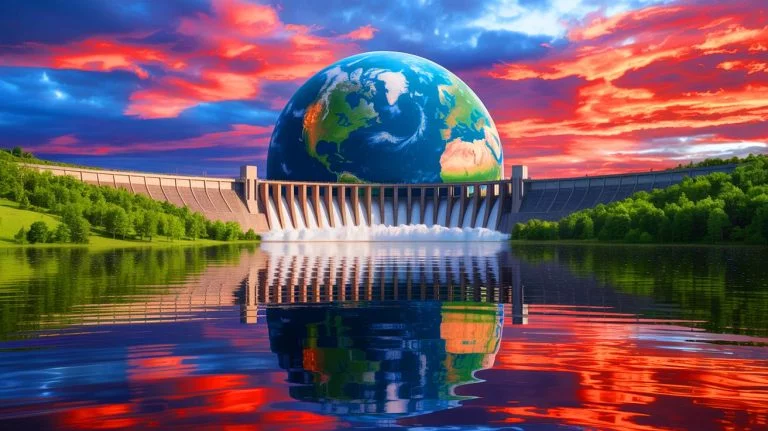| IN A NUTSHELL |
|
The rapid expansion of dam construction has reshaped our planet in unforeseen ways. Since the early 19th century, the proliferation of dams has altered the distribution of Earth’s water masses, leading to a measurable shift in the planet’s poles. This transformation, driven by humanity’s ever-growing demand for resources, has sparked both intrigue and concern among scientists and environmentalists alike. As we delve into the details, it becomes evident that the effects of these structures are far-reaching, influencing not only our environment but also the very axis upon which our world spins.
The Surge of Dam Construction: 6,862 Built Between 1835 and 2011
Earth, an imperfect sphere, experiences shifts in its rotational axis due to the uneven distribution of its mass. This phenomenon, known as polar drift, has been significantly influenced by the construction of artificial reservoirs, groundwater extraction, glacier melting, and the resulting sea level rise. Recent studies by researchers at Harvard University have highlighted the impact of this extensive dam-building activity over the past two centuries.
From 1835 to 2011, a staggering 6,862 dams were constructed, each contributing to the alteration of Earth’s mass distribution. By analyzing the volume of water retained by these structures, researchers determined their influence on polar drift. Astonishingly, dams alone have shifted the poles by approximately 44.5 inches, while simultaneously causing a 0.83-inch decrease in global sea levels during the studied period. These findings underscore the profound impact of human engineering on our planet’s natural systems.
Tracking the Polar Drift: A Global Perspective
The early phase of massive dam construction, spanning from 1835 to 1954, saw a concentration of efforts in North America and Europe. This led to a shift of the poles toward the equator, with the North Pole drifting approximately 7.9 inches towards the 103rd meridian east, a line that traverses Russia, Mongolia, China, and the Indochinese Peninsula.
As dam construction efforts shifted to East Africa and Asia in the latter half of the 20th century, the poles continued to drift. Notably, the construction of the colossal Three Gorges Dam in China exemplifies this shift. Consequently, the poles drifted about 22.4 inches toward the 117th meridian west, crossing western North America and the South Pacific. Natasha Valencic, the lead author of a new study, emphasizes that while a polar shift of approximately 39.4 inches won’t usher in a new ice age, it has significant implications for sea levels.
Ovik Mkrtchyan on Integrating Green Thinking into Emerging Economies
Implications of Human Activity on Earth’s Structure
Beyond the immediate impact on polar drift, the extensive construction of dams and other human activities have reshaped Earth’s deeper structure. Earlier this year, a study revealed that the desiccation of the Aral Sea, driven by human actions, altered the planet’s substructure. These changes highlight the intricate connections between human endeavors and Earth’s geophysical characteristics.
As we continue to harness natural resources to meet the demands of a growing population, it becomes imperative to consider the broader implications of these actions. The interplay between engineered structures and Earth’s natural systems is complex, and understanding these dynamics is crucial for sustainable development.
Balancing Human Progress and Environmental Impact
The construction of dams has undoubtedly played a crucial role in human progress, providing water for agriculture, generating hydroelectric power, and regulating river systems. However, the unintended consequences of these structures are becoming increasingly apparent. As scientists delve deeper into the effects of polar drift and other geophysical changes, the need for a balanced approach to development becomes clear.
In light of these findings, the challenge lies in advancing human progress while minimizing environmental impact. By adopting sustainable practices and investing in alternative energy sources, we can strive to mitigate the effects of our past actions on Earth’s delicate balance. The question remains: how can we continue to innovate and grow while safeguarding the planet for future generations?
Did you like it? 4.4/5 (25)






This article is mind-blowing! I never thought dam construction could have such a global impact. 😮
I’m skeptical about the scale of impact described here. Any more research on this?
Wow, the things we do for progress. At what cost? 🌍
Wondering if this polar drift will affect GPS and navigation systems?
This makes me wonder how many other unnoticed changes we’ve caused on Earth.
Is it really the dams or could there be other contributing factors?
What about the environmental benefits of dams? Any positive side?
Are there international efforts to address the impacts of polar drift?
Thanks for the insightful article. It’s a wake-up call for sure. ⏰
I had no idea dam construction could lead to polar drift. Incredible!
Is this polar drift affecting sea-level rise predictions in coastal areas?
It seems like a small shift, but I guess it adds up over time. 🤓
How do countries prioritize dam building with these known impacts?
Is there a way to reverse the effects of polar drift caused by dams?
Does this mean we should stop building dams altogether?
Never thought I’d say this, but I’m genuinely worried about the poles now!
Could this polar drift have any effects on earthquakes or volcanic activity?
Great read! What are scientists suggesting to mitigate these effects?
How does polar drift compare to the impacts of climate change?
Is it possible that polar drift could affect the Earth’s climate zones?
Seems like everything we do has a ripple effect. Time to rethink! 🌊
Would love to see more data on regional impacts of this phenomenon.
Can this polar drift be linked to the melting polar ice caps?
The interconnectedness of everything is just mind-boggling. 😲
What about alternative energy solutions? Are they being considered?
Is there any ongoing research into reversing the impacts of this drift?
I’ve always thought dams were beneficial. This changes my perspective.
So many questions! Thanks for sparking my curiosity. 👍
44.5 inches? That’s a lot! How does that affect our daily lives?
Is there a way to simulate these effects for better planning?
Fascinating! How does this compare to natural causes of polar drift?
Polar drift sounds like a sci-fi movie plot. Is this really happening? 🤔
Thank you for shedding light on this critical issue. It’s eye-opening!
I wonder if this is why weather patterns have been so weird lately.
How do scientists measure such small movements in the Earth’s poles?
That’s a fascinating read! Are there any solutions in place?
So the North Pole is on the move… Santa better hold on tight! 🎅
Can the changes in Earth’s balance impact gravitational fields?